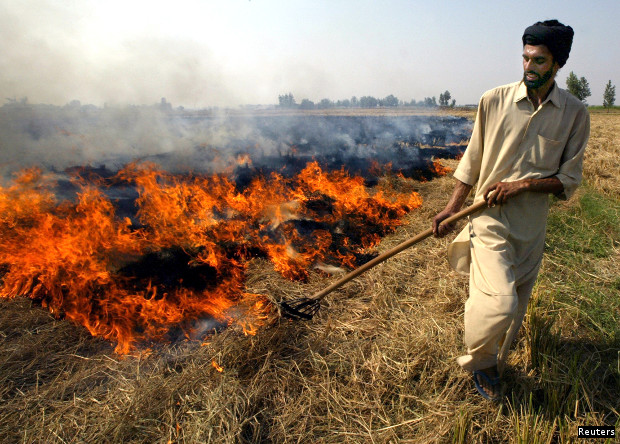Delhi’s Air Quality Could Improve 90% If Stubble-Burn In Fields Is Stopped
A farmer in Chandigarh burning paddy husks after a harvest. Stopping the burning of such stubble could improve air quality in Delhi by 90%, according to a 2016 study.
Farmers outside India’s capital have started to burn the post-harvest straw from their fields, heralding the onset of north India’s toxic-air season. Stopping the burning of such straw, or stubble, and other biomass could improve air quality in Delhi by 90%, according to a 2016 apportionment study by the Indian Institute of Technology, Kanpur.
Stubble burning was banned in 2015 by the National Green Tribunal (NGT), India’s apex court on matters concerning the environment.
While the NGT asked Punjab, Haryana, Delhi, Rajasthan & UP to enforce the ban on agriculture crop-residue burning in 2015 (with fines ranging from Rs 2,500 for landowners, with less than two acres, to Rs 15,000 for farmers with over five acres, per incident of crop burning) the burn continues.
Farmers have said that removing stubble from farms is expensive, and not economically viable without state support.
To change that, on October 13, the NGT ordered Punjab, Uttar Pradesh and Haryana to name biomass energy plants and other industries that could use crop residue as fuel and asked these states to ensure farmers got equipment to remove stubble at low or no cost depending on their financial and land owning capacity.
We storified a thread of tweets put out on October 16, 2017, to tell you how the stubble-burn affects the air over Delhi.
#Stubble burning continues in north India despite NGT ban. Follow our thread on #airpollution in & around India’s capital 1/12
— IndiaSpend (@IndiaSpend) October 16, 2017
What constitutes pollutants in Delhi’s air? 2/12 pic.twitter.com/7PmDiL25Tv
— IndiaSpend (@IndiaSpend) October 16, 2017
Stopping burning of biomass residue (incl. crops) could improve Delhi's air quality by 90%. Our Nov 2016 report 3/12 https://t.co/hTze3qcskI pic.twitter.com/w2dw5MyXYa
— IndiaSpend (@IndiaSpend) October 16, 2017
In 2015, the National Green Tribunal asked Punjab, Haryana, Delhi, Rajasthan & UP to enforce ban on agriculture crop residue burning 4/12
— IndiaSpend (@IndiaSpend) October 16, 2017
Landowners with <2 acre would pay Rs 2,500, those with 2-5 acre Rs 5,000, >5 acres Rs 15,000 per incident of crop burning: NGT said 5/12
— IndiaSpend (@IndiaSpend) October 16, 2017
As of Oct 2017, #cropburning continues; farmers say it is too expensive & only 10-15 days before new sowing to remove stubble 6/12
— IndiaSpend (@IndiaSpend) October 16, 2017
Cost of getting the stubble removed is Rs 3,500/hectare, more economic for farmers to burn stubble: https://t.co/T0POrOaS7l 7/12
— IndiaSpend (@IndiaSpend) October 16, 2017
As of Oct 9, 72 cases detected in Punjab with Rs 1.75 lakh penalty, 105 cases in Haryana, Rs52,000 compensation https://t.co/s2390aVoOs 8/12
— IndiaSpend (@IndiaSpend) October 16, 2017
Alternatives to burning: energy production, biogas generation, feedstock for cattle, composting, conversion in biochar: IIT-K study 9/12
— IndiaSpend (@IndiaSpend) October 16, 2017
On Oct 13, NGT ordered Punjab, UP & Haryana to name biomass energy plants, other industries which can use crop residue as fuel 10/12
— IndiaSpend (@IndiaSpend) October 16, 2017
States were also asked to provide balers, happy seeders to farmers either without or at nominal cost 11/12
— IndiaSpend (@IndiaSpend) October 16, 2017
A baler compresses raked crops. A happy seeder cuts & lifts rice straw, sows wheat into soil & deposits straw over sown area as mulch 12/12
— IndiaSpend (@IndiaSpend) October 16, 2017
(Patil is an analyst with IndiaSpend.)
We welcome feedback. Please write to respond@indiaspend.org. We reserve the right to edit responses for language and grammar.
__________________________________________________________________
“Liked this story? Indiaspend.org is a non-profit, and we depend on readers like you to drive our public-interest journalism efforts. Donate Rs 500; Rs 1,000, Rs 2,000.”



